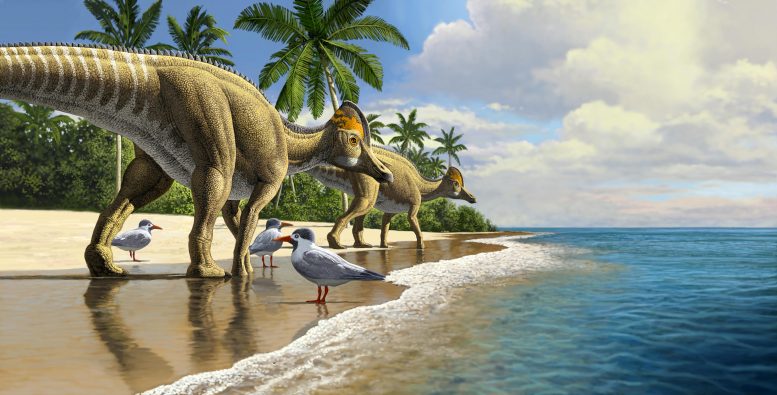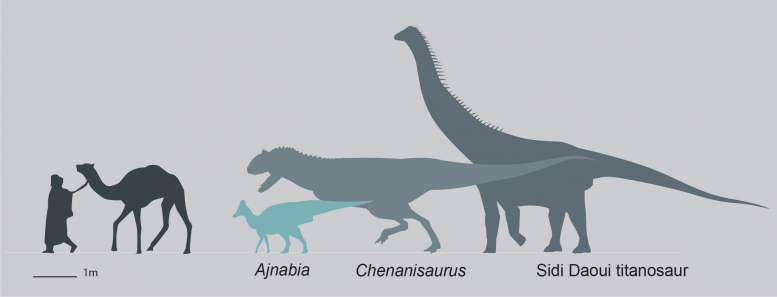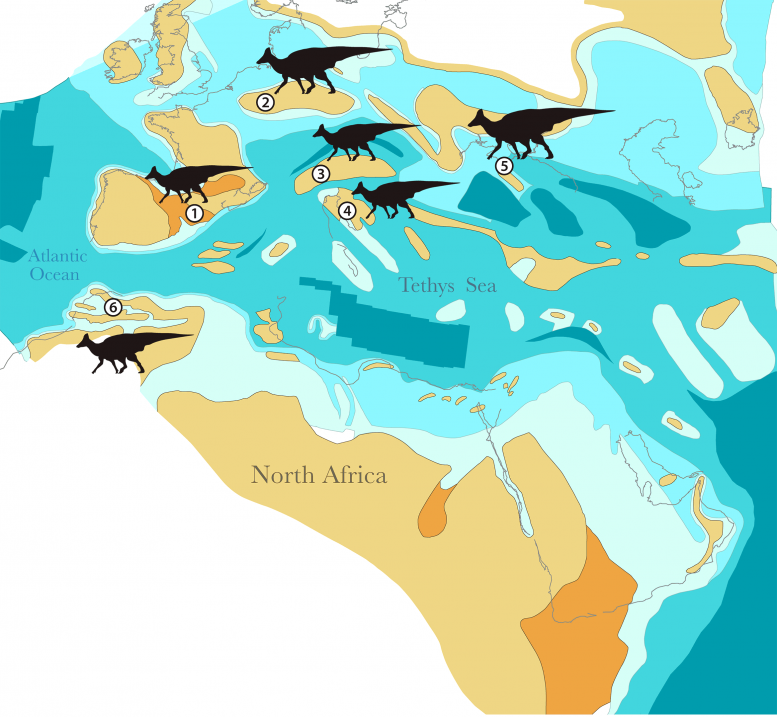
The first fossils of a duckbilled dinosaur have been discovered in Africa, suggesting dinosaurs crossed hundreds of kilometers of open water to get there.
The study, published in the journal Cretaceous Research, reports the new dinosaur, Ajnabia odysseus, from rocks in Morocco dating to the end of the Cretaceous, 66 million years ago. Ajnabia was a member of the duckbill dinosaurs, diverse plant-eating dinosaurs that grew up to 15 meters long. But the new dinosaur was tiny compared to its kin- at just 3 meters long, it was as big as a pony.
Duckbills evolved in North America and eventually spread to South America, Asia, and Europe. Because Africa was an island continent in the Late Cretaceous, isolated by deep seaways, it seemed impossible for duckbills to get there.
The discovery of the new fossil in a mine a few hours from Casablanca was “about the last thing in the world you would expect,” said Dr. Nicholas Longrich, of the Milner Centre for Evolution at the University of Bath, who led the study. Dr. Longrich said: “It was completely out of place, like finding a kangaroo in Scotland. Africa was completely isolated by water – so how did they get there?”

A study of Ajnabia’s distinctive teeth and jawbones shows it belonged to Lambeosaurinae, a subfamily of duckbills with elaborate bony head crests. Lambeosaurs evolved in North America before spreading to Asia and Europe, but have never been found in Africa before.
Reconstructing duckbill evolution, they found the lambeosaurs evolved in North America, then spread over a land bridge to Asia. From there, they colonized Europe, and finally Africa.
Because Africa was isolated by deep oceans at the time, duckbills must have crossed hundreds of kilometers of open water- rafting on debris, floating, or swimming — to colonize the continent. Duckbills were probably powerful swimmers — they had large tails and powerful legs, and are often found in river deposits and marine rocks, so they may have simply swum the distance.
“Sherlock Holmes said, once you eliminate the impossible, whatever remains, no matter how improbable, must be the truth,” said Longrich. “It was impossible to walk to Africa. These dinosaurs evolved long after continental drift split the continents, and we have no evidence of land bridges. The geology tells us Africa was isolated by oceans. If so, the only way to get there is by water.”
In reference to this feat, the dinosaur is named “Ajnabia odysseus.” Ajnabi is Arabic for “foreigner,” and Odysseus refers to the Greek seafarer.

Ocean crossings are rare, improbable events, but have been observed in historic times. In one case, green iguanas traveled between Caribbean islands during a hurricane borne on debris. In another, a tortoise from the Seychelles floated hundreds of kilometers across the Indian Ocean to wash up in Africa.
“Over millions of years,” said Longrich, “Once-in-a-century events are likely to happen many times. Ocean crossings are needed to explain how lemurs and hippos got to Madagascar, or how monkeys and rodents crossed from Africa to South America.”
But the fact that duckbills and other dinosaur groups spread between continents, even with high sea levels, suggests dinosaurs traveled across oceans as well. “As far as I know, we’re the first to suggest ocean crossings for dinosaurs,” said Longrich.
The international team of scientists was led by the University of Bath with researchers from the University of the Basque Country UVP/EHU (Spain), George Washington University (USA) and the Natural History Museum of Sorbonne University (France) / Universite Cadi Ayyad (Morocco).
Dr. Nour-Eddine Jalil, from the Natural History Museum of Sorbonne University (France) said: “The succession of improbable events (crossing an ocean by a dinosaur, fossilization of a terrestrial animal in a marine environment) highlights the rarity of our find and therefore its importance.
“Ajnabia shows us that hadrosaurs have set foot on African land, telling us that ocean barriers are not always an insurmountable obstacle.”
Reference: “The first duckbill dinosaur (Hadrosauridae: Lambeosaurinae) from Africa and the role of oceanic dispersal in dinosaur biogeography” by Nicholas R. Longrich, Xabier Pereda Suberbiola, R. Alexander Pyron and Nour-Eddine Jalil, 2 November 2020, Cretaceous Research.
DOI: 10.1016/j.cretres.2020.104678
Never miss a breakthrough: Join the SciTechDaily newsletter.
12 Comments
Who designed that picture. Dont you think the very modern terns on the beach are a bit out of place……by a few million years!! Come on editors!
I don’t think they are terns but stem birds.
Likely a deliberate choice by the illustrator to show that they were simultaneous with non-avian dinosaurs and has more frequent migration success (through long distance flight).
If Pangea existed they wouldn’t have to swim almost 2000 mi before continental shift
@Ed: Good idea, but the biogeography sucks since most of the hadrousars are found in one region.
The reason would be the timing.
Pangea is old.
“Pangaea or Pangea ( /pænˈdʒiːə/[1]) was a supercontinent that existed during the late Paleozoic and early Mesozoic eras.[2][3] It assembled from earlier continental units approximately 335 million years ago, and it began to break apart about 175 million years ago.” [“Pangaea” @ Wikipedia]
Hadrosaurs evolved later.
“During the latest Cretaceous (the Campanian and Maastrichtian Ages, 83.6–66 Ma), hadrosaurid hadrosauroids were the dominant herbivorous dinosaurs of the Asian and North American landmasses [1]. Europe at that time was an archipelago of comparatively small islands that was populated by both hadrosaurids and the more primitive non-hadrosaurid hadrosauroids (the latter including Telmatosaurus transsylvanicus from Romania and Tethyshadros insularis from Italy; [2]). European hadrosauroid remains are reported from the uppermost Cretaceous of Ukraine, Bulgaria, Romania, Italy, Slovenia, Germany, Belgium and the Netherlands, but most of the hadrosauroid sites are in the French and Spanish Pyrenees [2,3]. ” [“Ontogeny and taxonomy of the hadrosaur (Dinosauria, Ornithopoda) remains from Basturs Poble bonebed (late early Maastrichtian, Tremp Syncline, Spain)” @ Plos One]
So we are looking at not one old, but two younger supercontinents.
“Some 66 million years ago, as the Cretaceous period was drawing to a cataclysmic close, hadrosaurs of many different varieties were among the most common of herbivorous dinosaurs.
At least, that was the case on the supercontinent Laurasia – a mass that would later split to give us today’s continents of North America, Europe, and much of Asia.
Far across the ocean, a separate land mass known as Gondwana was instead ruled by a diversity of long-necked, lumbering sauropods.
The remains of these giants are commonly found in places such as Africa, India, Australia, and South America.
Where Hollywood might see fit to mix the two groups together, broad stretches of water between the continents and long periods of isolation meant by the late Cretaceous, duck-bills and long-necks would only have potentially mingled in distinct regions, such as in what is today Europe.
This newest member of the hadrosaurid family just might be a new exception.”
[“The Fossil of a Duckbill Dinosaur Has Been Found on The ‘Wrong’ Continent” @ Science Alert]
Guys, this, all of it is nonsense. Do a story about the Micronauts, at least have some fun with it.
Ironically all of your comment is nonsense.
Yeah but how did they know to go there?? Not like they had a map like yeaaaaahh Africa is a good place to go!! Lol smh
Babu G. Ranganathan*
(B.A. Bible/Biology)
NOT MILLIONS OF YEARS OLD! Evolutionary dating (including radiometric dating) is not infallible science, is based on certain built-in assumptions, and has often been proven to be contradictory and inconsistent. Please read my popular Internet article, ARE FOSSILS REALLY MILLIONS OF YEARS OLD? Just google the title followed by my name.
There’s a lot of evidence that the fossil layers were not deposited by gradual floods, which would have required millions of years. Rather, the evidence strongly points to a one world-wide flood, just as the Bible teaches. This one world-wide flood fossilized species and unleashed tremendous forces that changed the geology and topography of the earth.
The fossil layers in the real world are not even found in the sequence taught in evolutionary textbooks. There are many places where fossils of complex creatures are found beneath simpler ones, and there are fossils of mixed species existing in the same stratum which classic evolutionary textbooks teach should have been separated by millions of years. Of course a biblical world-wide flood would generally have buried and fossilized marine animals first with amphibians, reptiles and mammals to follow. Evolutionists have interpreted all of this into an evolutionary scenario spanning millions of years.
There is absolutely no proof of macro-evolution in the fossil record. The fossils of all species are found complete (not partially-evolved) with no evidence of actual transition from one kind to another. There are no fossils of fish, for example, with part fins, part feet to show that transition occurred from fins to feet. Besides this, partially-evolved species would be unfit for survival while waiting to be completed over millions of years.
ONLY LIMITED EVOLUTION (micro-evolution or evolution within biological “kinds”) is genetically possible (such as the varieties of dogs, cats, horses, cows, etc.), but not macro-evolution, or evolution across biological “kinds,” (such as from sea sponge to human). All real evolution in nature is simply the expression, over time, of already existing genes or variations of already existing genes. For example, we have breeds of dogs today that we didn’t have a few hundred years ago. The genes for these breeds had always existed in the dog population but never had opportunity before to be expressed. Only limited evolution or adaptation, variations of already existing genes and traits, is possible. Nature is mindless and has no ability to design and program entirely new genes for entirely new traits.
NEW SPECIES: Although new species can come into existence, they don’t carry any new genes. They’ve become new species only because they can’t be crossed back with the original parent stock for various biological reasons. A biological “kind” allows for new species but not new genes. Nature has no ability to invent new genes for new traits. Only limited variations and adaptations are possible in nature, and all strictly within a biological “kind” (i.e. varieties of dogs, cats, etc.).
THE FEW “INTERMEDIATE” (SO-CALLED TRANSITIONAL LINKS) IN FOSSILS claimed by evolutionists are highly disputed, even among the evolutionists. If macro-evolution really occurred there should be billions of indisputable intermediate fossils, not a few disputable ones. There’s not one example of a so-called transitional link that all evolutionists can agree on, not one.
What about the duck-billed platypus? It has traits belonging to both birds and mammals, but even evolutionists don’t argue that it’s a transitional link between birds and mammals.
Some evolutionists use similarities of traits between species as an argument for transitional forms. This is not a good argument because the traits they cite are complete, fully-formed, and fully functional, not in any true process of transition from one type of structure into another.
Genetic information, like other forms of information, cannot arise by chance, so it is more logical to believe that genetic and biological similarities between all forms of life are due to a common Designer who designed similar functions for similar purposes. It doesn’t mean all forms of life are biologically related!
What about natural selection? Natural selection can only “select” from biological variations that are possible and which have survival value. It doesn’t produce genes or biological traits. That’s why it’s called natural “selection.”
Many people have wrong ideas of how evolution is supposed to work. Physical traits and characteristics are determined and passed on by genes — not by what happens to our body parts. For example, if a woman were to lose her finger this wouldn’t affect how many fingers her baby will have. Changing the color and texture of your hair will not affect the color and texture of your children’s hair. So, even if an ape’s muscles and bones changed so that it could walk upright it still would not be able to pass on this trait to its offspring. Only changes or mutations that occur in the genetic code of reproductive cells (i.e. sperm and egg) can be passed on to offspring.
What about the new science of epigenetics? Epigenetics involves inheritable factors which can turn genes on, but epigenetics doesn’t alter the DNA code itself.
Modern evolutionists believe and hope that over, supposedly, millions of years, random mutations in the genetic code of reproductive cells caused by environmental radiation will generate entirely new genes for natural selection to use. This is total blind and irrational faith on the part of evolutionists. It’s much like believing that randomly changing the sequence of letters in a romance novel, over millions of years, will turn it into a book on astronomy! That’s the kind of blind faith macro-evolutionists have.
Mutations are accidents in the genetic code, are mostly harmful, and have no capability of producing greater complexity in the code. Even if a good accident occurred, for every good one there would be hundreds of harmful ones with the net result, over time, being harmful, even lethal, to the species. At best, mutations only produce further variations within a natural species. Even so, mutations are not the best explanation for variations within a natural species.
How could species have survived if their vital tissues, organs, reproductive systems, etc. were still evolving? A partially evolved trait or organ that is not complete and fully functioning from the start would be a liability to a species, not a survival asset. Plants and animals in the process of macro-evolution would be unfit for survival. For example, “if a leg of a reptile were to evolve (over supposedly millions of years) into a wing of a bird, it would become a bad leg long before it became a good wing” (Dr. Walt Brown, scientist and creationist) Survival of the fittest actually would have prevented macro-evolution (evolution across biological kinds!)
All the fossils that have been used to support human evolution have been found to be either hoaxes, non-human, or human, but not non-human and human.
The fossils show that all life came into existence as complete and fully-formed from the beginning, which is only possible by creation.
Visit the author’s latest Internet site: THE SCIENCE SUPPORTING CREATION (This site answers many arguments, both old and new, that have been used by evolutionists to support their theory).
Author of the popular Internet article, TRADITIONAL DOCTRINE OF HELL EVOLVED FROM GREEK ROOTS
*I have given successful lectures (with question and answer period afterwards) defending creation before evolutionist science faculty and students at various colleges and universities. I’ve been privileged to be recognized in the 24th edition of Marquis “Who’s Who in The East.”
Gosh… Your “research” is. Or very scientific… Your religion seems to be more important than actual research (method), that’s why your “results” are what be they are. When you believe and want to believe whatever the price… It’s hard to find answers or even doubt. Doubt and openness to the new is a prerequisite of good Science, not “science” to confirm one’s ancestral (> biblical) beliefs…
Meant “not” very scientific.
One key question is what would be the motivation. Unless this is assuming that a few pairs of them ended up drifting from one continent to the other by accident. e.g. falling into the ocean due to storms. Plus if they were good swimmers, wouldn’t they swim back to their familiar continent, instead of crossing into the unknown?
THANK YOU!!